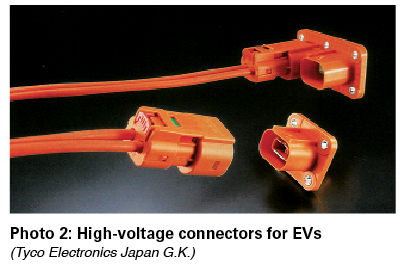

Connector Technologies Hinge on New Car Trends
The number of LiDAR sensors to be installed in a vehicle is expected to dramatically increase. The pursuit for miniaturization is required to accommodate many LiDAR sensors, and downsizing is also required for connectors for LiDAR sensors. Further downsizing and the improvement of waterproof performance are also required for connectors for millimeter wave (mmWave) radars for installation in next-generation vehicles.
With on-board high-speed transmission connectors, product development and the expansion of lineups of on-board high speed data (HSD) connectors, FAKRA standard-compliant connectors, and The United States Council for Automotive Research (USCAR) connectors have been active.
In the future, the installation of on-board Ethernet in vehicles is expected to advance, and the number of manufacturers aiming to enter the market of connectors for on-board Ethernet has been increasing. Connectors for on-board Ethernet are required to have very high reliability compared with those for ordinary Ethernet, and product development making use of advanced technologies has been underway.
The implementation of fifth-generation (5G) mobile communications standard on full scale will cause major changes to the automotive market as well. Setting their sights on such changes, connector manufacturers have been stepping up efforts in the development and strengthening of test systems for on-board connectors, including the establishment and addition of test centers and radio wave measurement sites in Japan and abroad.

Connectors for xEVs
With connectors for electrified vehicles (xEVs), such as electric vehicles (EVs) and plug-in hybrid vehicles (PHVs), the development of products that accommodate high currents and high voltages that are used in the vicinity of on-board inverters, EV drive motors, and on-board lithium ion batteries, have been active. High-voltage connectors, including products with rated voltage of 850V, have been developed.
There is a growing proposal for three-dimensional (3D) floating board-to-board connectors for power control units (PCUs) and motors installed on xEVs. In the development of new EVs, major automakers pursue the achievement of cruising range comparable to that of gasoline-powered vehicles.
In order to ensure safety, importance is placed on redundancy as well. For this reason, weight reduction, downsizing, automated assembly and higher efficiency are required for connectors. Connector manufacturers have been bolstering technological development to meet these needs.
The development of on-board high thermal resistant flexible printed circuit (FPC) connectors that withstand 125℃ and 150℃ for installation in demanding temperature environments, such as in the vicinity of the engine compartments, is also active.
Towards full-scale proliferation of EVs and PHVs, the improvement of cruising range per charge holds an important key. Hence, components for EVs face stronger needs for weight reduction than those for conventional gasoline-powered vehicles. Connector manufacturers have been focusing efforts on the pursuit of weight reduction of connectors for existing vehicles, as well. The development of small and lightweight connectors for on-board ECUs has been making progress.

 English
English Japanese
Japanese